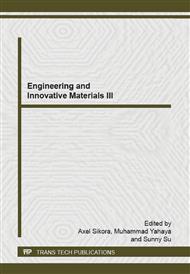p.189
p.193
p.198
p.204
p.209
p.214
p.219
p.224
p.229
Development of Natural Bio-Plantation Waste as Pulp for Paper Making
Abstract:
This project investigated the use of facile pulping methods to produce pulp from mixed bio-plantation waste fibres using sodium hydroxide, ethanol and garbage enzyme. Papers were successfully made from mixture of corn husk fibres with other bio-based green fibres such as banana stems and pineapple leaves. Soda pulping was found to be efficient in converting the cellulosic bio-fibres to the pulps used for paper making. The papers produced have low tensile strength, high water absorption, high bio-decomposition and degradation rate, as compared to commercial papers. SEM observation revealed that paper made from mixed bio-fibres have lightly cross-linked structures compared to heavily cross-linked or compact network structures found in commercial papers. The paper can be used in applications that require high water absorbency. The paper making process is more environmental friendly as it reduces the usage of wood fibres and hence reduces the environmental problem caused by deforestation.
Info:
Periodical:
Pages:
209-213
Citation:
Online since:
October 2014
Authors:
Keywords:
Price:
Сopyright:
© 2014 Trans Tech Publications Ltd. All Rights Reserved
Share:
Citation:


